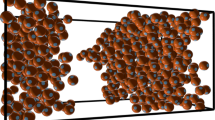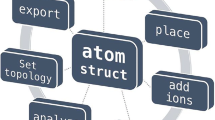Abstract
A polymodelling system (POLYMOD) is presented for varied 2D or 3D displays of chemical shapes, whether structural (molecular volumes distances, surfaces...) or electronic (molecular electrostatic potential, electron densities ...). The POLYMOD system manages reversible correspondences between calculation and representation spaces by immersing the molecules studied in a unique represetation space structured by a 3D grid box. This box, called COOBOX, defined by its point internal coordinates, is used to transform other coordinates into its own. Direct multi-slice images along thex, y, z axis provide access to a variety of derived operations around a molecular shape or set of shapes disposed in various manners. Interactive sub systems ensure Boolean operations and compare property shapes through the 3D grid. Clear separation of graphic routine and of downstream modelling programs leads to rapid and original generation of varied images (subimages, direct or composite images) which are then available for simulation strategies.
Similar content being viewed by others
Explore related subjects
Discover the latest articles, news and stories from top researchers in related subjects.References
Dubois JE, Laurent D, Weber J (1985) Chemical ideograms and molecular computer graphics. The Visual Computer 1:49–64
Lesk AM (1977) Macromolecular marionettes. Comput Biol Med 7:113–129
Max NL (1984) Computer representation of molecular surfaces. J Mol Graph 2:8–13
Scrocco E, Tomasi J (1973) Electrostatic molecular potential as a tool for the interpretation of molecular properties. Top Curr Chem 42:95–170
Dubois JE (1974) DARC system in chemistry. In computer representation and manipulation of chemical information. Wipke WT, Heller S, Feldmann R, Hyde E (eds) John Wiley, New York, pp 239–263
Marsili M, Floersheim P, Dreiding AS (1983) Generation and comparison of space-filling molecular models. Comput Chem 7:175–181
Allinger NL (1976) Advances in physical organic chemistry, vol 13, Gold V and Bethell D (eds) Academic Press, London
Chandra SU, Kollman P (1982) Gaussian 80 UCSF program. QCPE 446
Lavery R, Pullman A, Pullman B (1981) Steric accessibility of reactive centers in B-DNA. Inter J Quant Chem 20:46–62
Schlewer G, Wermuth CG, Chambon JP (1984) Analogues terazoliques d'agents gabamimétiques. Eur J Med Chem Chim Ther 19:181–186
Pearl LH, Honegger A (1983) Generation of molecular surface display. J Mol Graph 1:9–16
Richards FM (1977) Areas, volumes, packing and protein structure. Ann Rev Biophys and Bioeng 6:151–176
Connolly ML (1983) Solvent accessible surfaces of proteins and nucleic acids. Science 221:709–713
Author information
Authors and Affiliations
Rights and permissions
About this article
Cite this article
Dubois, J.E., Yue, S.Y. & Doucet, J.P. Grid stage modelling functions and molecular vector graphics. The Visual Computer 2, 367–378 (1986). https://doi.org/10.1007/BF01952421
Issue Date:
DOI: https://doi.org/10.1007/BF01952421




